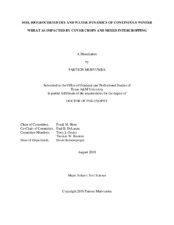| dc.description.abstract | Texas is ranked among the top winter wheat (Triticum aestivum L.) producers in USA. Monoculture wheat production systems are a customary practice in the Southern Great Plains, but have negative effects on ecosystem services and soil functions. The resurgence of cover crops technology in the twenty-first century has been viewed as restoring and sustaining soil ecosystem services and functions. The introduction of cover crops and intercropping during the fallow period may increase diversity, productivity and sustainability. This study was conducted for 3 years at the Smith/Walker Ranch near Vernon, TX, a rainfed leased landholding of Texas A&M AgriLife Research at Vernon. The objectives were to determine the impact of cover crops on nutrient cycling, soil microbial community structure and diversity, soil physical properties and soil moisture dynamics in continuous wheat systems. The study was a randomized complete block design with seven treatments replicated four times. Treatments were: (1) conventional till (CT) wheat without a cover crop; (2) no-till (NT) wheat without a cover crop; (3) NT wheat intercropped with turnip (Brassica rapa subsp. Rapa )/radish (Raphanus sativus) without a summer cover crop; (4) NT wheat with a terminated summer cover crop; (5) NT wheat with a grazed summer cover crop; (6) NT wheat intercropped with turnip/radish with a terminated summer cover crop; and (7) no-till wheat intercropped with turnip/radish with a grazed summer cover crop. Legumes and grasses multi-species mix was used as a warm-season cover crop mix.
Introduction of cover crops in continuous wheat systems during the fallow period significantly depleted soil moisture and was reflected in the following wheat period and exacerbated by recurrent drought when study was initiated in 2013. Treatment effects were more pronounced in the top 0-60 cm of the soil profile. Conventional till and NT treatments without cover crops and NT intercropped with radishes and turnips without summer cover crops recorded
highest stored soil moisture compared to all NT cover crops treatments during periods of peak cover crops growth. The first two years of investigation showed no differences in soil moisture storage among all no cover crops treatments; however, CT trended lowest during the third year, indicating negative tilling effects. The second and third years of cover crops, which had more normal precipitation, showed improved soil water recharge by all cover crop treatments, with cover crop treatments storing highest soil water compared to no cover crops treatments.
Soil nitrate-N was lowest under cover crop treatments compared to no cover crop treatments in the fall and was related to N immobilization and cover crops using N during growth. Generally, no significant soil organic carbon (SOC) sequestration was observed during this investigation. However, water extractable organic C (WEOC) showed a gradual increase under no-till with cover crops.
Total living soil microbial biomass, microbial activity and organic C were numerically higher for all NT treatments compared to CT. Conventional till had the least organic N, C, NHv4^+–N and COv2–C emission compared to other treatments, although not always significant. No significant effects due to intercropping or grazing were recorded.
Conventional till wheat resulted in the highest soil bulk density compared to all other treatments. Aggregate-size distribution was significantly different in the top 5 cm compared to 5-10 cm depth (p<0.05). Large macroaggregates (>2 mm) were highest under the grazed NT with cover crops plus intercropping treatment. Conventional till resulted in the quickest time to surface runoff initiation compared to all other treatments. Runoff volumes collected were highest under CT compared to NT with cover crops and recorded the highest total P, NHv4^+–N and total solids in runoff (p<0.05). No-till with cover crops improved soil water infiltration, transmission and holding capacity. No significant effects due to turnips and radishes were observed. | en |


